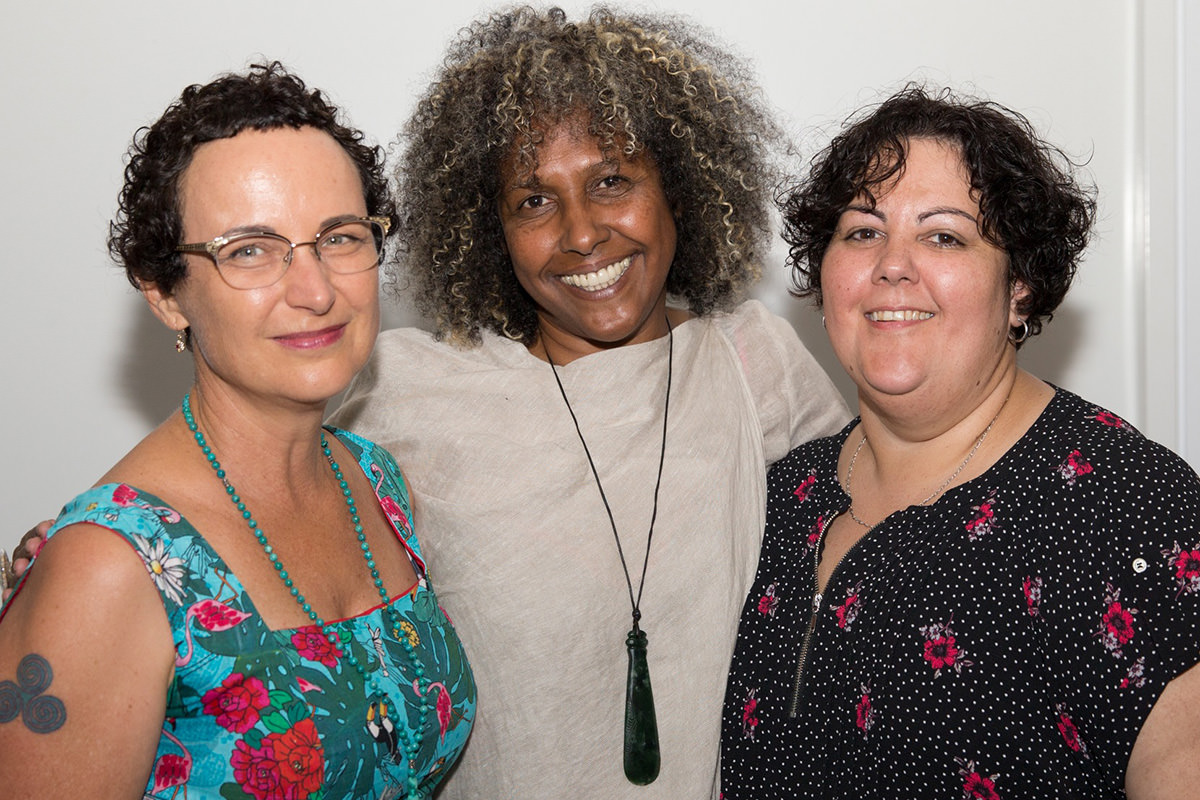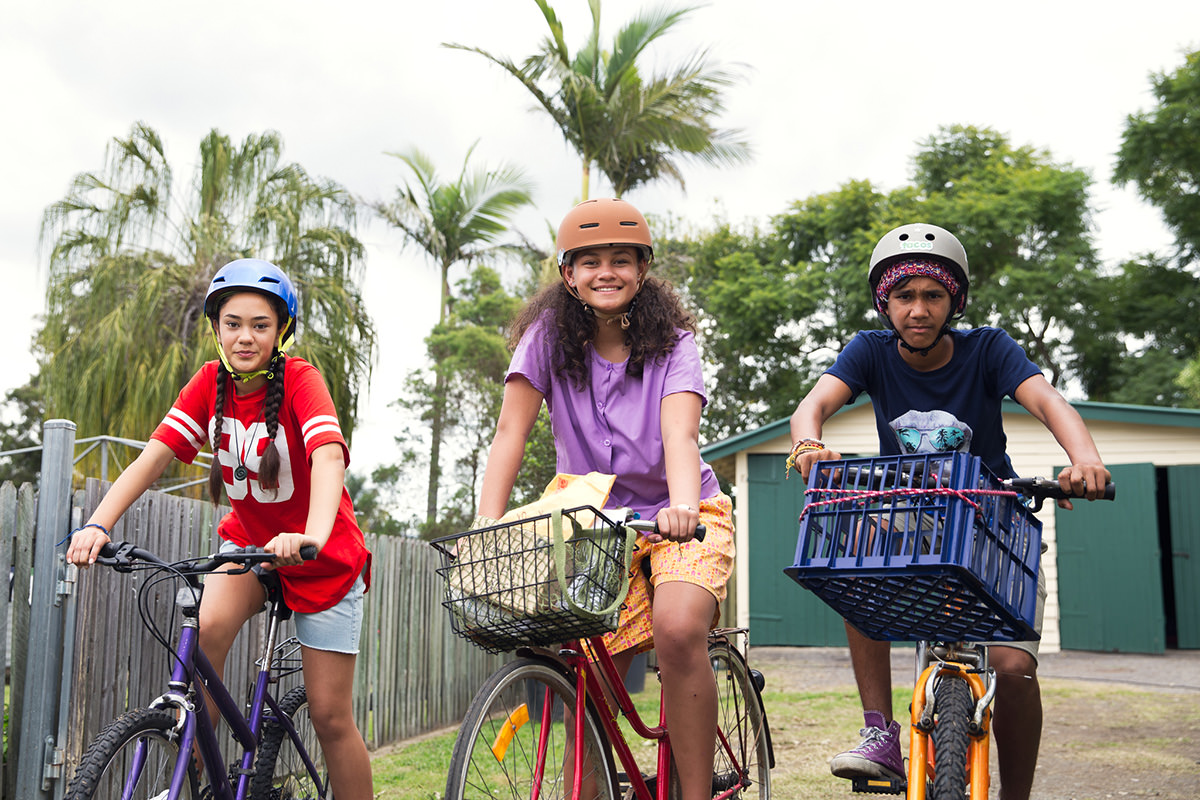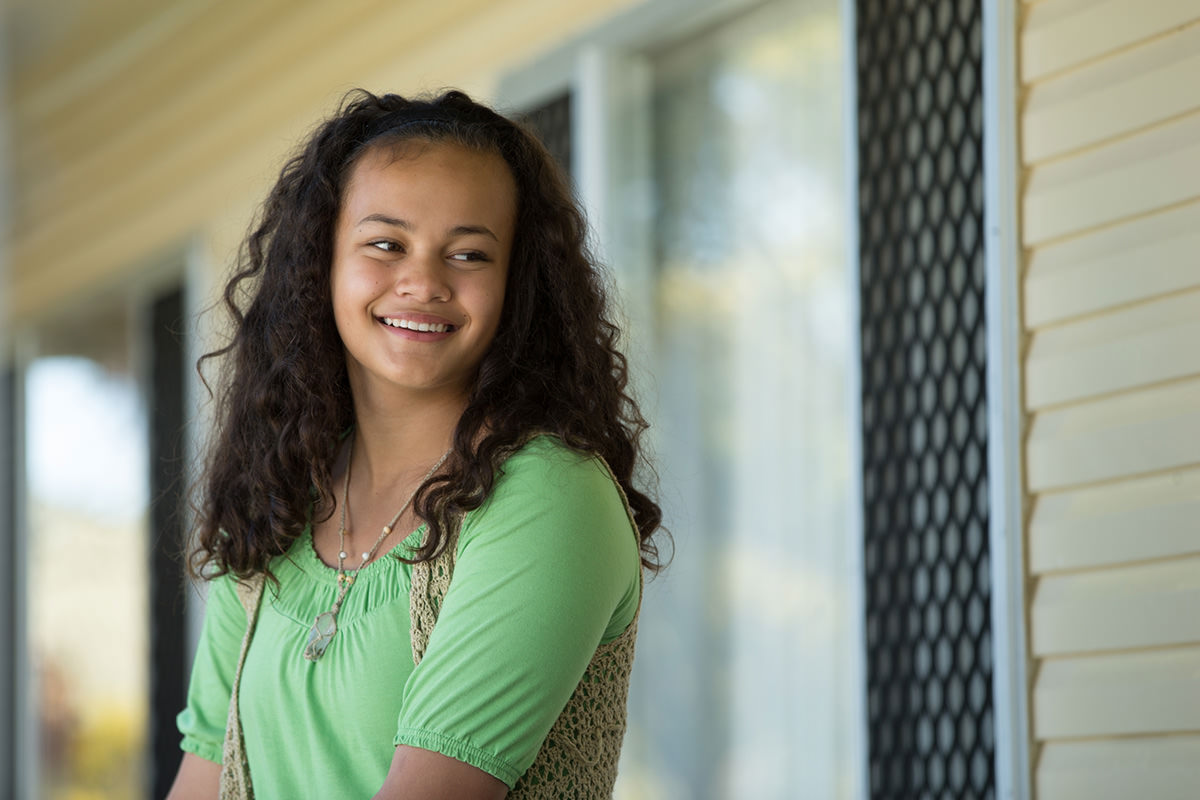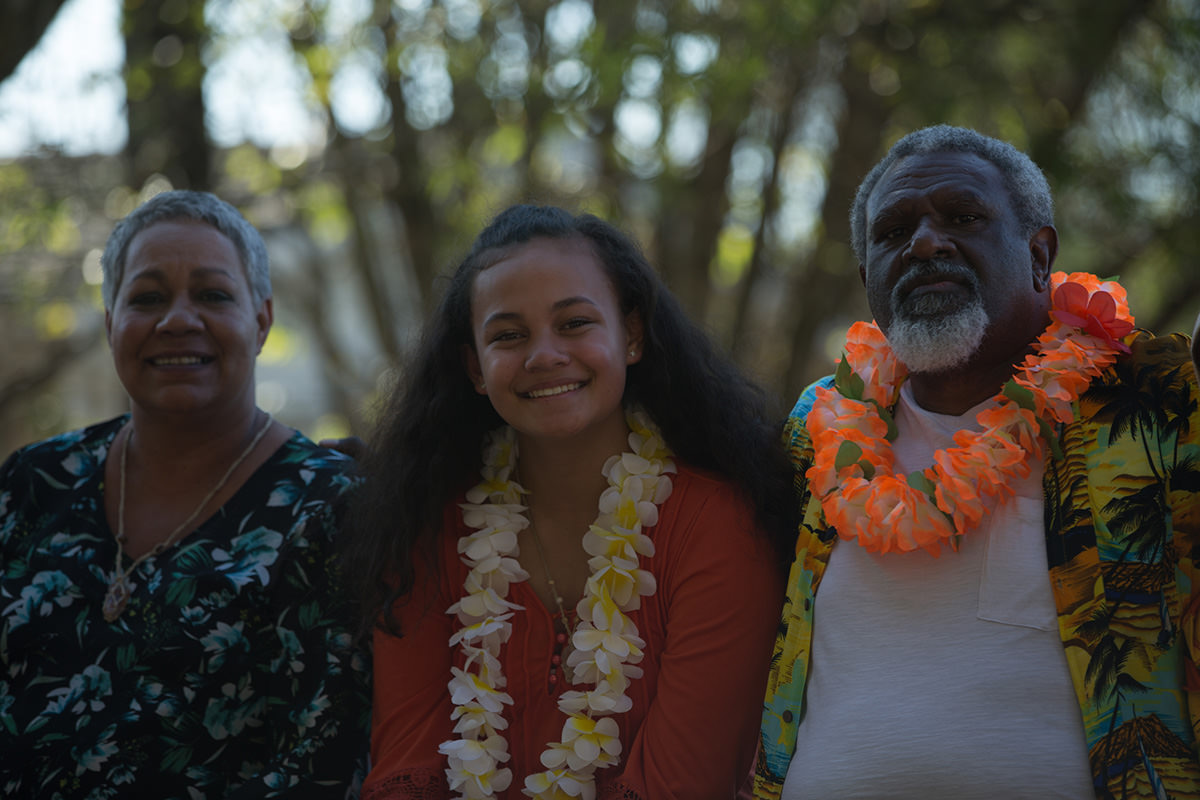The collaborative nature of Grace Beside Me
Four years after the launch of NITV/ABC kids’ series Grace Beside Me, producers Dena Curtis and Lois Randall look back on what made the popular series work.
 Lois Randall, Sue McPherson and Dena Curtis at the launch of Grace Beside Me in Beaudesert (Photo credit: Magpie Pictures)
Lois Randall, Sue McPherson and Dena Curtis at the launch of Grace Beside Me in Beaudesert (Photo credit: Magpie Pictures)
One of the first writers’ rooms for Grace Beside Me had more than a dozen people in it.
For producers Dena Curtis and Lois Randall, this was a valuable and necessary starting point for a series that needed to deftly manage sensitive subject matter and multiple unique perspectives, which was based on the YA book from First Nations writer Sue McPherson, and set to be broadcast on NITV, ABC and Disney.
“They started out really big,” Randall says, “with lots of people, including fantastic, wonderful collaborators like Murray Lui who's a DOP and is great at story ideas, and Shari Sebbens was also in our first workshop.”
Curtis said that first room “had about 12 or 14 people” all up.
“Then by the end, once we really knew what the series was, there were probably about four or five of us,” Curtis says. “Sue [McPherson] was always with us, in all of those writing rooms.”
Grace Beside Me is currently streaming on SBS On Demand and follows the adventures of Fuzzy Mac, who lives with her eccentric Nan and Pop and learns on her 13th birthday that she can communicate with spirits. It’s based on the novel of the same name by McPherson, which McPherson, Randall and Curtis first adapted into a short film called Nan and a Whole Lot of Trouble, through an initiative of the First Nations Departments of Screen Australia and the ABC.
“That's how Dena and I actually first met,” Randall says. “My production company Magpie Pictures optioned [the book] Grace Beside Me because it was an underlying work for this short film, which Sue wrote, I produced, and Dena directed.”
It was during post-production that they discussed expanding the book into a series. They spoke to then Head of First Nations at Screen Australia Penny Smallacombe, which led to a well-timed meeting with Mary-Ellen Mullane at NITV, who were considering children’s content for the first time.
“Understandably, NITV didn't have the resources to fully fund drama independently,” Curtis says. “They needed a partner to do that – and the obvious partner for us was ABC.”
According to Randall, it was ABC’s then Head of Children's and Education Michael Carrington who opened the door for the possibility of a co-commission with NITV. This paved the way for ABC/NITV co-commissions like Little J & Big Cuz and Thalu under the same financing structure.
But the financing and partner support – from Screen Australia, Screen Queensland, a pre-sale to Disney and an advance from international distributor 9 Story – took time. Throughout that, the writers’ rooms continued.
“Every time someone new came on we had to change it,” Randall says. “So that was over a year, at least, that process.”
The collaboration and consultation also continued – with McPherson, with the Traditional Owners of Mununjali Country where the series was eventually filmed, and writers representative of Aboriginal, South Sea Islander and Māori characters.
Looking back, this unique, story-driven process for Grace Beside Me, Randall says “was such a joy.”
“It’s been one of the highlights of my professional life as an experience and a learning experience,” she says. “Also [for] that relationship that we developed with the local community.”
 Grace Beside Me
Grace Beside Me
WORKING WITH THE COMMUNITY
One of the big changes in adapting Grace Beside Me for screen was shifting the story location to Queensland – with Screen Queensland a financing partner.
“The first important step was that Sue gave us her blessing to relocate it,” Randall says.
“For Sue, the Country had to feel a little bit similar, so she needed somewhere that had mountains and that felt like a community where her characters would live and wasn't tropical.”
They found that exact spot in southeast Queensland in Beaudesert, in the Scenic Rim. But even then, it wasn’t a simple location change. The book Grace Beside Me is set in the same Country that McPherson is from – Wiradjuri. It features Wiradjuri language, practices and cultural elements. This new location was on Mununjali Country.
“We felt that it wasn't appropriate that we take Wiradjuri language and place it on this Country when it was so rich in its own language, cultural stories, knowledge and community,” Curtis says. “And that's very much what Grace Beside Me was about – the connection to Country, so it was really important that we told this story authentically.”
To go any further though, would require the permission and consultation of the Traditional Owners of Munujali Country.
“We had a meeting with the Mununjali Elders Council,” Randall remembers, “which was a really pivotal moment for us. It was me and Sue and Dena, and they kind of grilled us and sent us outside to wait.”
Once the Elders Council has discussed it, the three were called back in to answer more questions.
“They were so wise the way they approached it,” Randall says. “They gave us their endorsement, but they wanted to know what the benefits for the local community were going to be and how we were going to engage the local community, which obviously was something we really wanted to do anyway. They also allocated three Elders to work with us to be our story consultants and our point of connection.”
It was a formal paid agreement with the Mununjali Elders Council and the three Elders as consultants, who Randall, Curtis and McPherson would meet with for sessions in the park. More importantly, over time, they established relationships and trust.
“Working with the community was amazing,” Curtis says. “We got to put Mununjali language into the series, which was a language where, at the time, there weren’t too many speakers, so that was really exciting. We worked very closely with them. We used to send them newsletters every month just to update what we were doing.”
Randall says they also cast some of the Elders as Aunties and Uncles in the show. “That was special,” she says.
The emphasis was on respectful collaboration and communication to create an authentic series that stayed true to the messages of McPherson’s novel – something that also extended to the writers’ rooms.
THE WRITERS’ ROOMS
McPherson’s novel features a rich and diverse story world that Curtis and Randall wanted to be reflected in the writers’ rooms.
The character of Fuzzy has grown up with a mix of Aboriginal Australian, Irish and South Sea Islander traditions, while one of Fuzzy’s best friends Tui is Māori, and different episodes weave in aspects of these various cultures.
Curtis says: “And it was just making sure that we had those authentic voices in there.”
For episode nine, which featured a South Sea Islander story, they worked with consultant Emelda Davis, who also put the team in touch with a local South Sea Islander artist in the Scenic Rim that helped create the artworks and story.
Meanwhile, Briar Grace-Smith was brought on as a Māori writer to help build Tui's character and that family, but then became part of the collaborative team and went on to write episodes five and six, and co-wrote episode one.
Why was this important to the Grace Beside Me team?
Curtis explains: “I think authenticity only comes from a lived experience, and you can't retell that story unless you've been in those shoes. You don't have inherent knowledge; you haven't had an experience from that perspective or of that culture or as that person.”
Without the authenticity of those writers or collaborators, Curtis says you could still technically tell that story, but it wouldn’t be through a “true lens.”
“So I could tell a story about Lois,” Curtis says, “but it's through my lens, not through her own story and vice versa.”
Curtis says the argument that a writer may have lived in an Aboriginal community for five years and therefore can tell that story is not enough.
“You only know that character through your own perspective and your own experiences, not their lived experience. It's getting people to understand the difference of that,” she says.
“You can tell stories as a whitefella that's gone to live in a community, but you need to collaborate with an Indigenous person to be able to get their experience and their perspective.
“And I think that's a massive challenge in writing and creating content with diverse voices is ensuring the authentic voice is in the story and understanding why that is.”
The danger is not elevating those voices and creating characters or story worlds that feature or reinforce caricatures and stereotypes.
“Particularly in children's television, you really don't want to be promoting those kinds of ideas about people and cultures,” Curtis says.
The other aspect about writing for children’s TV was finding that balance – of an entertaining story for kids, that worked for the various audiences for NITV, ABC and Disney, and still had the authentic voices of McPherson’s characters.
It’s something Randall says writer, story producer and script producer Sam Carroll (H20: Just Add Water, The Elephant Princess, Mako Mermaids) was instrumental in.
“She came on board in that lead story role, and she's got a lot of experience in kids' TV, which also just really helped us shape our episodes and craft something that worked for children's television, including our broader partners and audiences beyond NITV.”
 Grace Beside Me
Grace Beside Me
MANAGING DIFFERENT BROADCASTERS
Grace Beside Me might have had two national broadcasters in NITV and ABC, but their audiences didn’t overlap.
“That's a really important point,” Randall says, “because it meant that everyone was open to that co-financing model because they weren't competing for an audience.”
The notes from the broadcasters were also invaluable when it came to tackling complicated, emotional storylines around the Stolen Generation and the meaning of Sorry Day, such as with episode four ‘Sorry’.
Curtis says she can remember Libbie Doherty (then ABC Commissioning Editor, now Head of Children’s Production) “drumming into us, ‘it's E for entertainment, not education’.”
“That was a massive challenge. We had to make sure that our A stories in the series were always entertaining,” Curtis says. With the ‘Sorry’ episode, that also meant being respectful to First Nations audiences, educating audiences who didn’t know about the Stolen Generations, and making sensitive subject matter understandable.
“We wanted to tell that story and we wanted to do it properly, so that was a real challenge in finding a metaphor for what the Stolen Generation actually was to 10-year-old in an entertaining way.”
Disney coming on board for the third broadcast window came down to right place, right time.
“I actually pitched it to Disney at Screen Forever,” Randall says, when they were still in early development. “They wanted something for eight to 12-year-old girls with an interesting original lead character, so it was just that timing.”
Disney were very interested, but needed the rest of the financing and partners in place to move forward.
Randall says with the support of Screen Australia and Screen Queensland, the last piece of the financing puzzle was complete when international distributor 9 Story came on board after a middle-of-the-night telephone pitch (in pre-Zoom days).
“Being Canadian, they had a real interest in First Nations voices,” Randall says, and were blown away by the majority of First Nations writers in the team. “They put up a significant distribution advance, which was the final thing that we needed in our puzzle [but they also] gave it a lot of profile in international markets.”
With Disney then officially on board, next came the “complicated and drawn-out process” of negotiating the windows and the hold backs for those three partners.
“It was this big visual timeline… but we got there,” Randall says.
“And I think definitely worth it,” adds Curtis.
 Grace Beside Me
Grace Beside Me
WHY IT’S WORTH IT
When Curtis, Randall and McPherson were growing up, there weren’t any stories like Grace Beside Me on television – there weren’t any contemporary kids like Fuzzy, Yan and Tui having adventures in a regional town where you have the freedom to roam and be in nature.
“For all three of us,” Curtis says, “I think why we were able to collaborate so well on this series is that we all come from similar backgrounds – we all grew up in the country or out bush. And we wanted to tell a story about a bunch of friends that grew up in a small town like we did…. To give a voice to regional kids.”
Saddle Club was about the closest Curtis had as a kid. “That was as white as anything, but, you know, horses are country!” she laughs.
Now, as well as Grace Beside Me, and CAAMAs ground-breaking Double Trouble, there are a number of series that aren’t set in the big cities, like Little J & Big Cuz, Robbie Hood, Thalu and newest addition MaveriX.
Curtis thinks the collaborative nature of Grace Beside Me also pushed the series.
“Even Lois and I, as producers we didn't always agree on things, but there was a process of working through that, and it always made for a better outcome at the end of the day,” she says. “Our process as a creative team was very respectful and we were in a space where we could disagree and know that we'll find a better outcome. That was really lovely.”
The opportunity to bring in diverse writers and voices had the same impact – they brought in new elements and challenged old ones, so together the team could take the story somewhere new.
Randall says that collaborative approach – which extended to working with NITV, ABC, the other partners, and the Mununjali Elders – holds so much value, both as a learning experience and in the end product.
“Funding pressure makes it difficult because you get funded for a set amount of days and stages, but sometimes it’s actually necessary and valuable… Particularly on something like this [to have] those different voices and to sit back and listen and let it find its own way.”
Watch Grace Beside Me on SBS On Demand now.

What to read next
Screen Australia’s Head of Indigenous Penny Smallacombe reflects on a changing industry.
09 Dec 2020
Caris Bizzaca